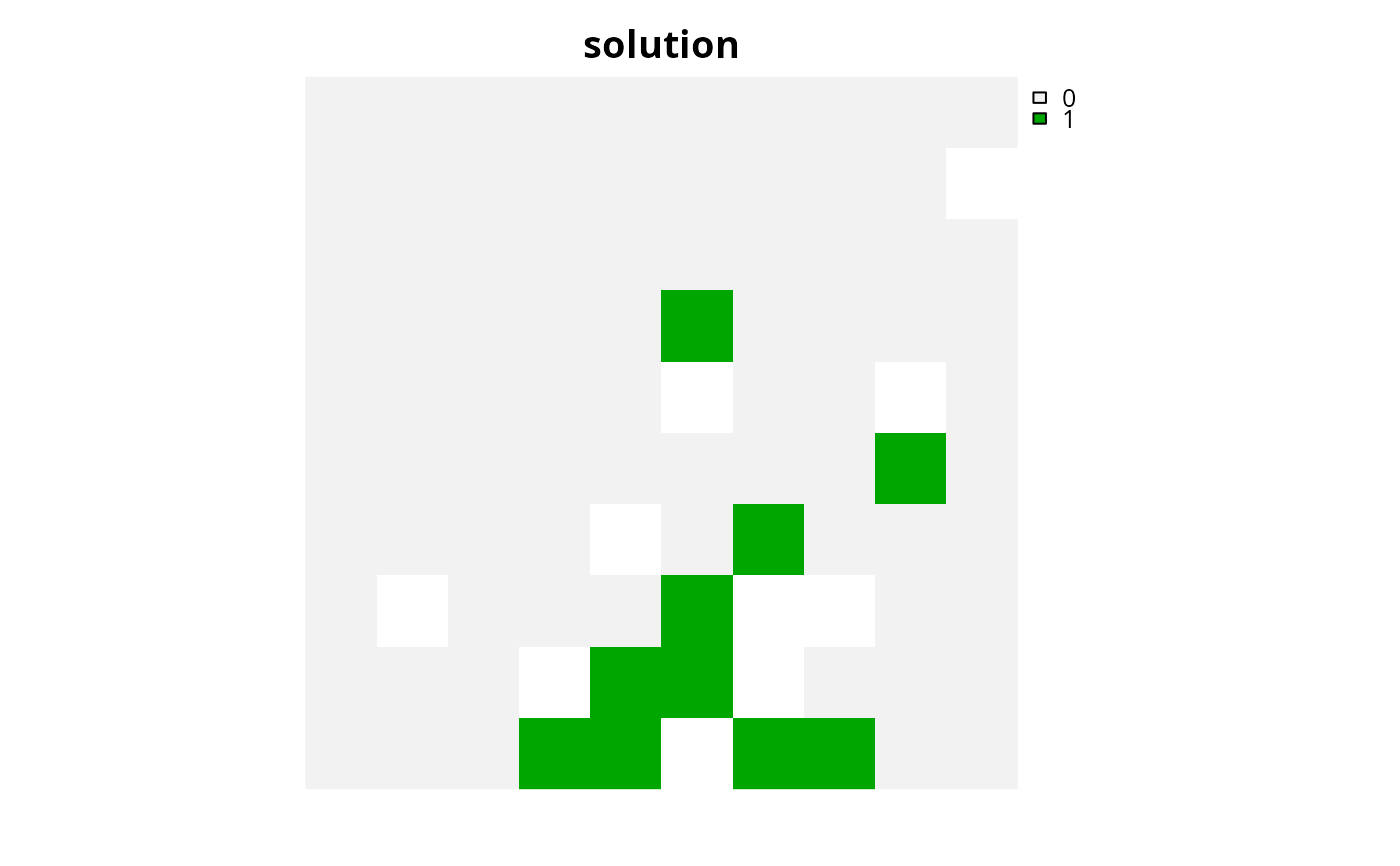Specify that the IBM CPLEX software should be used to solve a conservation planning problem (IBM 2017) . This function can also be used to customize the behavior of the solver. It requires the cplexAPI package to be installed (see below for installation instructions).
Usage
add_cplex_solver(
x,
gap = 0.1,
time_limit = .Machine$integer.max,
presolve = TRUE,
threads = 1,
verbose = TRUE
)Arguments
- x
problem()object.- gap
numericgap to optimality. This gap is relative and expresses the acceptable deviance from the optimal objective. For example, a value of 0.01 will result in the solver stopping when it has found a solution within 1% of optimality. Additionally, a value of 0 will result in the solver stopping when it has found an optimal solution. The default value is 0.1 (i.e., 10% from optimality).- time_limit
numerictime limit (seconds) for generating solutions. The solver will return the current best solution when this time limit is exceeded. The default value is the largest integer value (i.e.,.Machine$integer.max), effectively meaning that solver will keep running until a solution within the optimality gap is found.- presolve
logicalattempt to simplify the problem before solving it? Defaults toTRUE.- threads
integernumber of threads to use for the optimization algorithm. The default value is 1.- verbose
logicalshould information be printed while solving optimization problems? Defaults toTRUE.
Value
An updated problem() object with the solver added to it.
Details
IBM CPLEX is a
commercial optimization software. It is faster than
the available open source solvers (e.g., add_lpsymphony_solver() and
add_rsymphony_solver().
Although formal benchmarks examining the performance of this solver for
conservation planning problems have yet to be completed, preliminary
analyses suggest that it performs slightly slower than the Gurobi
solver (i.e., add_gurobi_solver()).
We recommend using this solver if the Gurobi solver is not available.
Licenses are available for the IBM CPLEX software to academics at no cost
(see < https://www.ibm.com/products/ilog-cplex-optimization-studio/cplex-optimizer>).
Installation
The cplexAPI package is used to interface with IBM CPLEX software.
To install the package, the IBM CPLEX software must be installed
(see https://www.ibm.com/products/ilog-cplex-optimization-studio/cplex-optimizer). Next, the CPLEX_BIN
environmental variable must be set to specify the file path for the
IBM CPLEX software. For example, on a Linux system,
this variable can be specified by adding the following text to the
~/.bashrc file:
Please Note that you may need to change the version number in the file path
(i.e., "CPLEX_Studio128"). After specifying the CPLEX_BIN
environmental variable, the cplexAPI package can be installed.
Since the cplexAPI package is not available on the
the Comprehensive R Archive Network (CRAN), it must be installed from
its GitHub repository. To
install the cplexAPI package, please use the following code:
For further details on installing this package, please consult the installation instructions.
References
IBM (2017) IBM ILOG CPLEX Optimization Studio CPLEX User's Manual. Version 12 Release 8. IBM ILOG CPLEX Division, Incline Village, NV.
See also
Other functions for adding solvers:
add_cbc_solver(),
add_default_solver(),
add_gurobi_solver(),
add_highs_solver(),
add_lsymphony_solver,
add_rsymphony_solver()
Examples
# \dontrun{
# load data
sim_pu_raster <- get_sim_pu_raster()
sim_features <- get_sim_features()
# create problem
p <-
problem(sim_pu_raster, sim_features) %>%
add_min_set_objective() %>%
add_relative_targets(0.1) %>%
add_binary_decisions() %>%
add_cplex_solver(gap = 0.1, time_limit = 5, verbose = FALSE)
# generate solution
s <- solve(p)
# plot solution
plot(s, main = "solution", axes = FALSE)
 # }
# }
